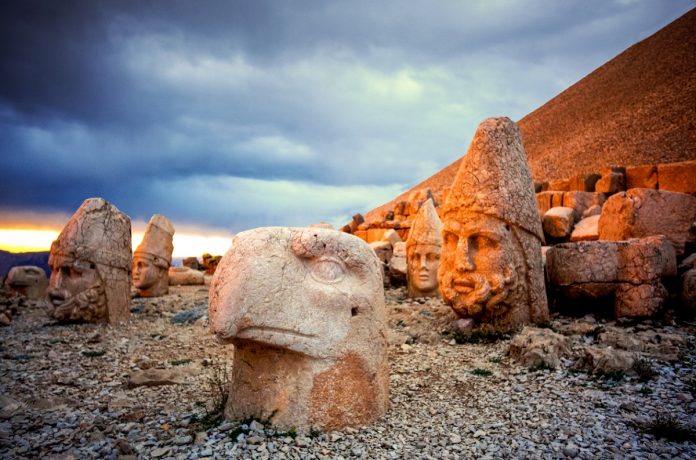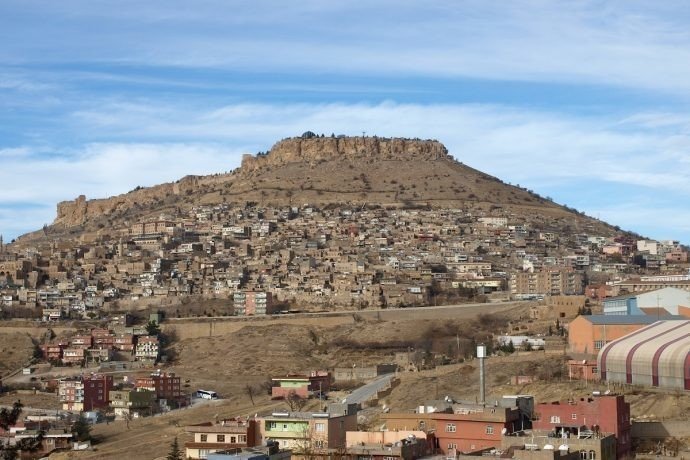Some 11,500 years ago humans built what is considered to the first ever place of worship. The temple in question was found in modern day Turkey, a land that in the centuries and millennia that followed has seen countless peoples come and go, each bringing their own versions of what today we call religion or faith.
Over the course of history, remnants of these ancient and more contemporary faiths had been scattered all across this land. Some, of course, have not withstood the test of time, but those that have give us today a precious insight into the spiritual part of the humankind’s past.
Fortunately, in Turkey you have a chance to discover many of these mystical places that enchant you with their mysteries, leaving many things unsaid.
Göbeklitepe
The obvious place to start is Göbeklitepe, an archeological site that hosts a structure often described as “the world’s oldest temple.” As already mentioned, it’s approximately 11,500-years-old.
This prehistoric site is located in southeastern Turkey’s Şanlıurfa province.
The discovery of this place and further research quite literally rewrote human history. You see, before Göbeklitepe a scientific consensus was that humans began building places of worship only after they switched from hunter-gatherer practices to a sedentary lifestyle, but Göbeklitepe’s temple was built by hunter-gatherers, rendering the previous theories wrong.
Göbeklitepe’s massive T-shaped stone pillars that form the temple are decorated with abstract shapes and carvings depicting various wild animals.
Scientists, however, are unable to neither interpret the pictograms nor explain the nature of this prehistoric “religion,” leaving the mysteries of this monumental place unresolved and up to imagination.
Ephesus
Ephesus is a tremendous site in terms of religious importance that for centuries played a role not only in the ancient beliefs of Greeks and Romans but also Christianity.
This great city of the past hosted several major Greek and Roman temples, ruins of which – some well-preserved and some not so much – can be found as you stroll around Ephesus.
In the past the city’s most famous structure was the Temple of Artemis, one of the Seven Wonders of the Ancient World. Unfortunately, as is with other Wonders, only tiny fragments of the temple survived to this day.
Later in history, Ephesus became a center of early Christianity.
Ephesus was one of the Seven Churches of Revelation, the seven major churches of Early Christianity, that were each addressed a letter proclaimed by Jesus and recorded by John of Patmos in the Book of Revelation.
The city on the Aegean coast is also believed to be the place where Virgin Mary, mother of Jesus, spent the last years of her life. The House of the Virgin Mary is only a couple of kilometers (miles) away from the city. It’s a major pilgrimage site for Christians and has been visited by three sitting popes. The site was discovered in the 19th century purely based on the visions of Anne Catherine Emmerich, a Roman Catholic nun.
Meanwhile, John the Apostle is also believed to have been buried in Ephesus. Today ruins of the 6th-century Basilica of St. John stand over his supposed burial site.

Mount Nemrut
Underneath the clouds, high up a mountain lays a place that takes the definition of “mystical” to heart.
The peak of Mount Nemrut is the site of a unique, more than 2,000-year-old tomb-temple accompanied by giant statues of both Greek and Iranian gods, animals and the person to whom the tomb belongs – King Antiochus I of Commagene. The temple survived the millennia to stand today as the testament to the blend of Greco-Iranian religious beliefs of the Kingdom of Commagene.
The statues, that were “beheaded” some time over the course of centuries, stand around the structure as if guarding its secrets.
The biggest secret of the site, by the way, remains unresolved: the actual tomb of Antiochus I is yet to be found. Despite decades of excavations and research the royal’s resting place was not identified. Scientists, however, widely agree that Antiochus rests somewhere on Nemrut.
Another mystery about Nemrut and its stone “residents” is how they were made or how they were brought up to the mountain. Theses huge statues were supposedly 8-9 meters (26-30 feet) tall.
As you watch the famously marvelous sunrise or sunset on Nemrut, you can ponder about the mysteries of this mountain.
Altar of Zeus
More than three millennia ago the king of Greek gods Zeus and his wife Hera sat on Mount Ida and watched the famous Trojan War unfold. At least that’s what Homer told us in his Iliad.
Zeus’ alleged observation point can be found today in western Turkey’s Çanakkale. It’s a structure built on a huge rock that from above looks like a lone stone island surrounded by the sea of pine trees.
Researchers working in the region believe that this place, built on a hill overlooking the Aegean Sea and Edremit Bay, was the place described by Homer.
The area called the Altar of Zeus on Dede Tepe can be accessed by a ladder of steps carved into the rock. There are altar niches, sitting platforms and a hollowed-out cistern space. This cistern, which is the size of a room under the altar and contains water, is called the Cave of Zeus.
As you stand in this mystical place you will find yourself feeling a unique sense of solitude and detachment.
Hierapolis
At the foot of a true natural wonder of Pamukkale, snowy-white cascading travertine terraces filled with mineral water from hot springs, once lied the city of Hierapolis.
Hierapolis means “holy city” and was supposedly named so due to a large number of various temples built in the area.
Today ruins of these temples attest to the city’s Hellenistic and Roman periods.
Among them the most mystifying is the Ploutonion (Pluto’s Gate) or simply called the “Hell’s Gate.” Pluto, or Hades in Greek mythology, was the ruler of the underworld. Legends claim that the living who would come near the gate would drop dead and be taken to the underworld. Recently scientists, however, gave a more trivial possible explanation for this phenomenon, suggesting it may have been due to the excessive release of carbon dioxide from the underground in the gate’s vicinity.
The Christian apostle Philipp is believed to have lived in Hierapolis. He was allegedly crucified in the city, and a martyrium was built on that spot. Philipp’s possible tomb is also located in Hierapolis.
Here in Hierapolis, when you walk around the Ploutonion, Nymphaeum, other temples, Martyrium and the Necropolis you can’t help but be mystified by them and what ancient stories they may hold.

Cappadocia
The otherworldly landscapes of the Cappadocia are very well-known and are the first images that pop in one’s mind at the mention of this region in central Turkey. Yet what lies underneath these landscapes is at least as attention-worthy.
Cappadocia was home to one of the first ever Christian converts who had to find ways to hide from persecution. To do so, they supposedly built underground cities carving deep into the local soft volcanic rock.
These underground settlements could house tens of thousands of people and had many features of normal cities, from schools to chapels and churches to even stables.
Numerous multilevel underground cities can be found throughout Cappadocia, revealing and concealing at the same time their cryptic past in the narrow tunnels and stairways.
Sümela Monastery
Sümela Monastery, one of Turkey’s most unique landmarks, is located in the Black Sea province of Trabzon.
Nestled on a ledge in a steep cliff and backdropped by emerald green mountains, the Greek Orthodox monastery is a breathtaking sight.
The building, supposedly built some 1,700 years ago, surrounded by nothing but a huge rock and the forest looks shrouded in mystery, especially if looking from below.
Until the 20th century, the monastery was home to the icon of the Virgin Panagia Sumela. It is believed to have been drawn by Apostle Luke, a disciple of Jesus and the author of one of the Gospels. The icon was later handed to Greece.
The monastery that now serves as a museum today highlights the contrast between the surrounding wild nature and the monumental structure of antiquity.

Mardin
Mardin, the city whose history is the true meaning of multiculturalism, harmonious cohabitation and tolerance.
The southeastern Turkish city is a place that united people who had been divided in so many ways. People of various ethnicities, languages, cultures and faiths as well as confessions have built their lives here alongside each other for centuries.
This city of distinct architecture, whose skyline unites Muslim minarets and Christian crosses, does not leave anyone indifferent, driving an irresistible desire to get to know it better.
Narrow streets, stone houses and views of the endless surrounding plains create a unique atmosphere that allows visitors to get a peak of how people lived thousands of years ago.
Konya
The most common association people have with the city of Konya is Rumi, also known as Mevlana.
Rumi, who spent a good half of his life in the now Turkish city, is widely regarded as the greatest Sufi mystic. Konya became the birthplace of the Mevlevi Sufi order, which was established after Rumi’s death by his followers.
They later became known as the “whirling dervishes,” named so over their practice of whirling as a form of meditation. UNESCO declared the Mevlevi Sufi’s whirling ceremony as the Masterpiece of the Oral and Intangible Heritage of Humanity.
To this day Konya remains the center of the mystical Mevlevi Order. Every year the city draws thousands of pilgrims and tourists for the Whirling Dervish Festival that was established to preserve and popularize the centuries-old practice.











